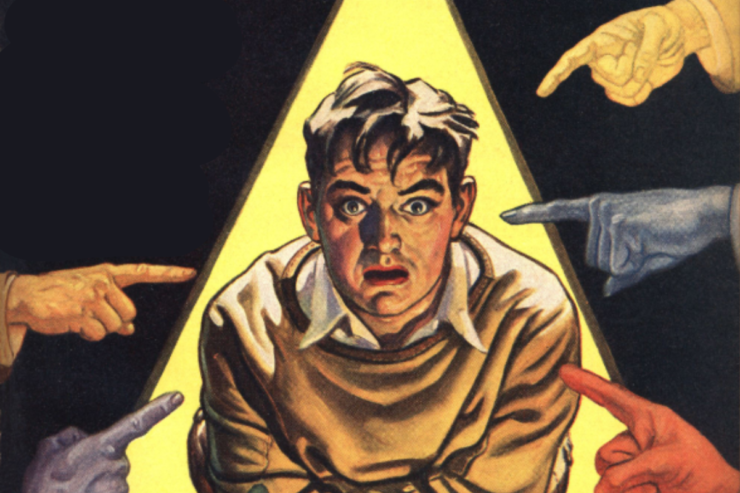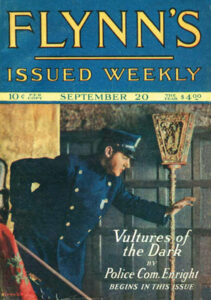 One hundred years ago, the Red Star News Company — owned by Frank A. Munsey — debuted a magazine known simply as Flynn’s. Issued weekly, it was a companion to their popular general fiction magazine, Argosy All-Story Weekly.
One hundred years ago, the Red Star News Company — owned by Frank A. Munsey — debuted a magazine known simply as Flynn’s. Issued weekly, it was a companion to their popular general fiction magazine, Argosy All-Story Weekly.
The second of Munsey’s specialized titles — after The Railroad Man’s Magazine — Flynn’s debuted with its September 20, 1924 number. The magazine’s editor was William J. Flynn, the former chief of the U. S. Secret Service.
In that first issue, the magazine promised to go “far back into the recesses of his (Flynn’s) own life for thrills and action; those early days in New York when he himself set his feet on the downtown pavements and met the shock of the lawless.” All this and more for just ten cents a week!
In addition to some of the leading writers of the 1920s — Madeleine Sharps Buchanan, Karl W. Detzer, Oscar J. Friend, and others — Flynn used a contribution from a brand new writer — Richard E. Enright, Police Commissioner of New York City — to fill the first issue of the new Munsey detective pulp. Later issues featured Max Brand, Agatha Christie, J. S. Fletcher, R. Austin Freeman, Arthur B. Reeve, Caroline Wells, and other popular writers of the day.
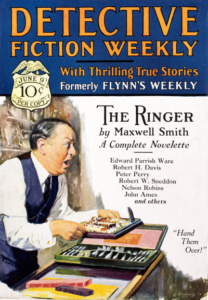 Bill Flynn — or should we say Chief Flynn — stayed with the magazine for nearly four years and a pair of name changes. In May 1926, it became Flynn’s Weekly. A little more than a year later, it became Flynn’s Weekly Detective Fiction. Beginning with its June 2, 1928 number — around the time when Howard V. Bloomfield became the magazine’s editor — it became Detective Fiction Weekly, the title it carried for most of its 929 total issues.
Bill Flynn — or should we say Chief Flynn — stayed with the magazine for nearly four years and a pair of name changes. In May 1926, it became Flynn’s Weekly. A little more than a year later, it became Flynn’s Weekly Detective Fiction. Beginning with its June 2, 1928 number — around the time when Howard V. Bloomfield became the magazine’s editor — it became Detective Fiction Weekly, the title it carried for most of its 929 total issues.
In the pages of The Black Mask, Carroll John Daly and Dashiell Hammett had introduced a more hardboiled style of writing to the detective story. By 1928, the technique had taken off, encouraged by Joseph T. Shaw. The Black Mask editor preferred . . .
Characters with motives and engaging in action logically born of those motives. Both motive and action to be so realistic as to insult the intelligence of none; to seem, not only possible, but inevitable.
Although the more traditional mystery yarns of Christie, Reeve, Wallace, and others continued in Detective Fiction Weekly for some time to come, Bloomfield began to introduce toughness, action, violence, and even humor to the magazine. Hardboiled writer Erle Stanley Gardner debuted in the magazine with its November 10, 1928 issue. Carroll John Daly popped in now and then. Later came Frederick Nebel and others.
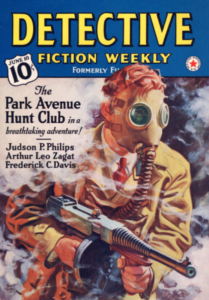 Although series characters such as Victor Maxwell’s Sergeant Riordan and Edward Parrish Ware’s Tug Norton and Ranger Jack Calhoun had been around since the days of Flynn’s, after Erle Stanley Gardner introduced con-artist Lester Leith to readers in early 1929, Detective Fiction Weekly had a real winner on its hands.
Although series characters such as Victor Maxwell’s Sergeant Riordan and Edward Parrish Ware’s Tug Norton and Ranger Jack Calhoun had been around since the days of Flynn’s, after Erle Stanley Gardner introduced con-artist Lester Leith to readers in early 1929, Detective Fiction Weekly had a real winner on its hands.
Along came more series characters: H. Bedford-Jones’ jewel thief, Riley Dillon; Donald Barr Chidsey’s hard-boiled Miami cops, Morton & McGarvey; Carroll John Daly’s Satan Hall who “hunted the kings of the underworld and its toughest killers”; Stanley Day’s hotel dick Shamus Maguire; J. Allan Dunn’s undercover cop, Jimmy Dugan, and his criminal mastermind known as The Griffin; T. T. Flynn’s private eye team of Trixie Meehan & Mike Harris; Gardner’s Sydney Zoom, The Patent Leather Kid, and other characters; Johnston McCulley’s The Mongoose — “The Crook Who Hunts Human Snakes”; H. H. Matteson’s Alaskan detective, Hoh-Hoh Stevens; Frederick Nebel’s street cop Sgt. Brinkhaus; Milo Ray Phelps’ comic crook Fluffy McGoff and police detective Murray Magimple; Judson P. Philips’ millionaire vigilantes, The Park Avenue Hunt Club; Anthony Rud’s oddball investigator Jigger Masters; Richard B. Sale’s newspaper men Daffy Dill and Candid Jones; Sidney Herschel Small’s Jimmy Wentworth of the San Francisco Chinatown squad; Eugene Thomas’ Vivian Legrand: The Lady from Hell; and many others.
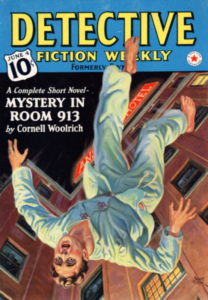 Although he never contributed a series to the pulp, suspense master Cornell Woolrich placed over fifty stories with the magazine, starting with “Death Sits in the Dentist’s Chair” in the August 4, 1934 issue of Detective Fiction Weekly. Other popular writers who appeared in the long-running magazine included Cleve F. Adams, Leigh Brackett, Fredric Brown, John K. Butler, Hugh B. Cave, Raymond Chandler, Leslie Charteris, Dale Clark, Frederick C. Davis, Norbert Davis, Bruno Fischer, Steve Fisher, Frank Gruber, Day Keene, Philip Ketchum, Fred MacIsaac, Peter Paige, Roger Torrey, and Lawrence Treat. Contrary to some beliefs, Dashiell Hammett never appeared in any of the magazine’s various incarnations.
Although he never contributed a series to the pulp, suspense master Cornell Woolrich placed over fifty stories with the magazine, starting with “Death Sits in the Dentist’s Chair” in the August 4, 1934 issue of Detective Fiction Weekly. Other popular writers who appeared in the long-running magazine included Cleve F. Adams, Leigh Brackett, Fredric Brown, John K. Butler, Hugh B. Cave, Raymond Chandler, Leslie Charteris, Dale Clark, Frederick C. Davis, Norbert Davis, Bruno Fischer, Steve Fisher, Frank Gruber, Day Keene, Philip Ketchum, Fred MacIsaac, Peter Paige, Roger Torrey, and Lawrence Treat. Contrary to some beliefs, Dashiell Hammett never appeared in any of the magazine’s various incarnations.
Mixing old-style mysteries with hardboiled detectives, loveable rogues, vigilante heroes, true crime, and tales of suspense, Detective Fiction Weekly continued as a weekly magazine through its August 2, 1941 number before becoming a twice monthly. Its title was shortened to Detective Fiction. A year later, it became a monthly with its April 1942 issue. Shortly thereafter, it was Flynn’s Detective — largely a true detective type of magazine.
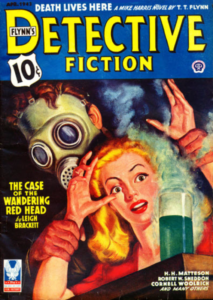 At the end of 1942, Flynn’s Detective was acquired by Popular Publications and became Flynn’s Detective Fiction, a title it retained through its August 1944 number. Afterward, it was absorbed into Dime Detective Magazine.
At the end of 1942, Flynn’s Detective was acquired by Popular Publications and became Flynn’s Detective Fiction, a title it retained through its August 1944 number. Afterward, it was absorbed into Dime Detective Magazine.
In 1951, Popular revived the magazine as Detective Fiction. It lasted for six issues, mixing new stories with reprints from Black Mask, Detective Fiction Weekly, and Detective Tales. John D. MacDonald contributed stories to four of the six issues. The final issue of Detective Fiction was its July 1951 number. With the pulp industry contracting, it was gone for good.
Although it never achieved the importance of Black Mask or the popularity of Dime Detective Magazine, Detective Fiction Weekly enjoyed a long life. It’s still part of our collective memory, 100 years after its debut.
Our featured image is Emmett Watson’s cover for the June 22, 1940 issue of Detective Fiction Weekly, illustrating Cornell Woolrich’s novella, “Finger of Doom.”
Our lead image is Lejaren Hiller’s cover for the September 20, 1924 number of Flynn’s, the original name of Detective Fiction Weekly. According to David Saunders, Hiller used transparent oil paints to retouch enlarged black-and-white photographs for the cover. The cover for the June 9, 1928 issue is also by Hiller.
Our final two Detective Fiction Weekly images are by Emmett Watson. The cover for the June 10, 1939 number illustrates “Death Walks the Avenue,” a Park Avenue Hunt Club adventure written by Judson P. Philips, while the June 4, 1938 cover illustration is for the Cornell Woolrich suspense novella, “Mystery in Room 913.”
Closing out our post is Rafael DeSoto’s cover for the April 1943 issue of Flynn’s Detective Fiction, the fourth of twenty issues published by Popular Publications during the 1940s after it took over the magazine from the Frank A. Munsey Company.
A fan of detective fiction — particularly the hardboiled variety — please welcome Pete Collins to the PulpFest staff. We look forward to his contributions to our website.

